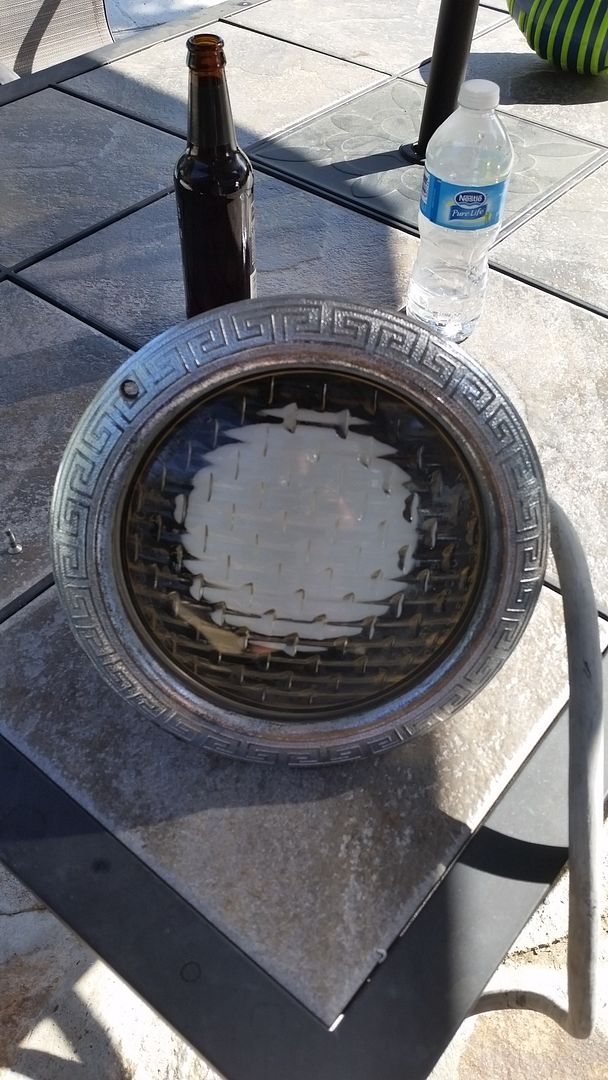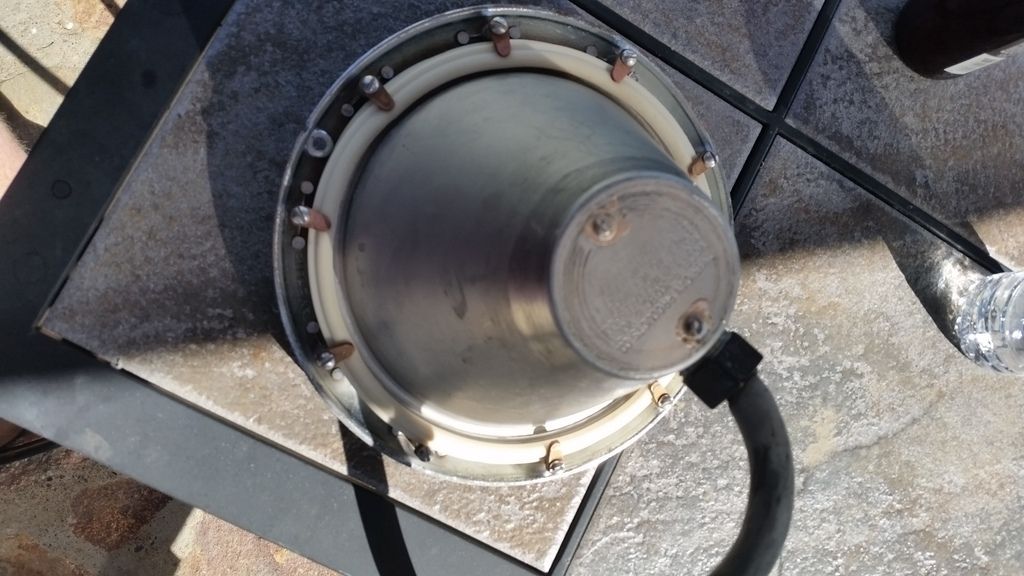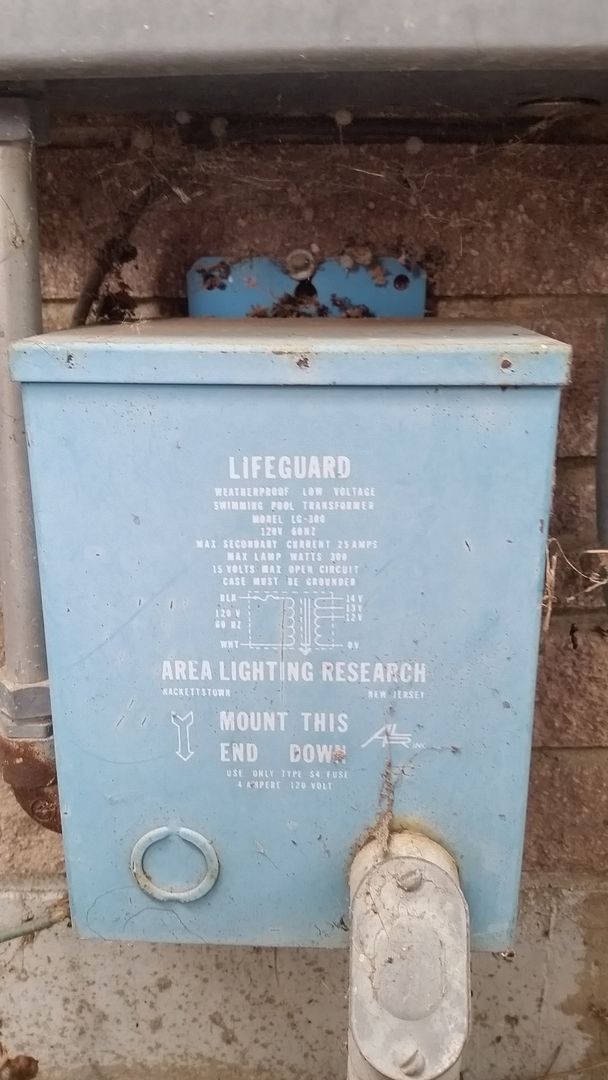I plan to have an electrician come out to test my existing GFCI as I am concerned it is not working correctly. It appears to be the original unit which was installed in the 60's. I am very handy but I'm not stupid and won't risk electrocution of my family to save a few bucks.
Having said that, I am pretty handy and fairly cheap so I plan to do the rest of the work myself. Here's what I'm up against.
I drained my pool this year and noticed that the pool light was about half full of water. Not knowing any better, I assumed it would fill back up when I filled the pool. (I had heard from the previous owner that the light needed to be under water or it would burn out due to heat) I noticed when the pool was full, there was still an air bubble filling approximately half of the lens.
So after some research, I realized the previous owner was either misinformed or lying (as there should be zero water in the fixture and certainly not half way filled with water! I have no idea how long the pool light has been exposed to water but after inspecting the gasket install the former owner did, I think it is safe to assume it has had a significant amount of water in the fixture for the for the entire 2 years I've owned the pool. Not once has the gfci or breaker tripped and the light has worked the entire time. I do know for sure based upon the corrosion in the socket that it has been submerged in water for awhile. I think we got really lucky here.
So I removed the fixture from the niche, brought it out of the pool and replaced the gasket. As soon as I put it in the water, air bubbled up out of it as it started to fill with water. Now replacing the gasket is tough because whoever installed this light in the 60's cut the cord too short and you can barely get it out of the pool. There is nowhere near enough length to get it face down on a towel to work on it properly.
So I disconnected the wiring in the junction box, removed the fixture, replaced the gasket again and submerged the unit to test for leaks. It appears to be holding watertight just fine now but I'm a bit spooked by all of this. I didn't wire it back up and have no intention of doing so.
So on to my concern! Given the potential danger, I am not satisfied with the way the current gasket is designed and am looking to upgrade my pool light fixture. I could probably reinstall the current unit but I am going to replace it with something safer, newer and with a longer cord for the future. I like the LED option mainly because it is a sealed unit and I will not have to rely on a gasket to keep water out of the light. I would be happy with an incandescent replacement at around $150.00 but I don't have any idea if the gasket system has been upgraded or not over the years.
Is an LED unit a safer bet than an incandescent upgrade? We are talking a difference of roughly $300.00 between an incandescent and an LED as far as I've been able to find online.
The reviews on Amazon are mixed. I was looking at a Pentair LED unit and 20% of the reviews were 1 star with various complaints.
I have no preference on color change vs a white light. But I'm willing to spend the extra $300.00 or so for an LED if that gives me more peace of mind and keeps my swimmers safe.
I'm planning on upgrading my existing electrical panel with some sort of automated panel in the near future. It will be a major brand but I haven't decided between the available options just yet.
I want to do this once focused on safety with an eye on future compatibility with the new panel but honestly don't need to frills of a color changing light.
So which way should I go? Have the incandescent gaskets been improved since the 60's? Are they safe?
Should I buy an LED? If so, which one is going to be safe and a good value at roughly $500.00?
Where can I find the best product at the best price online?
I've attached a couple of pictures of the old light for reference. It is a 120v system and I need at least 11 feet of cord.
Thanks in advance for your suggestions!


Having said that, I am pretty handy and fairly cheap so I plan to do the rest of the work myself. Here's what I'm up against.
I drained my pool this year and noticed that the pool light was about half full of water. Not knowing any better, I assumed it would fill back up when I filled the pool. (I had heard from the previous owner that the light needed to be under water or it would burn out due to heat) I noticed when the pool was full, there was still an air bubble filling approximately half of the lens.
So after some research, I realized the previous owner was either misinformed or lying (as there should be zero water in the fixture and certainly not half way filled with water! I have no idea how long the pool light has been exposed to water but after inspecting the gasket install the former owner did, I think it is safe to assume it has had a significant amount of water in the fixture for the for the entire 2 years I've owned the pool. Not once has the gfci or breaker tripped and the light has worked the entire time. I do know for sure based upon the corrosion in the socket that it has been submerged in water for awhile. I think we got really lucky here.
So I removed the fixture from the niche, brought it out of the pool and replaced the gasket. As soon as I put it in the water, air bubbled up out of it as it started to fill with water. Now replacing the gasket is tough because whoever installed this light in the 60's cut the cord too short and you can barely get it out of the pool. There is nowhere near enough length to get it face down on a towel to work on it properly.
So I disconnected the wiring in the junction box, removed the fixture, replaced the gasket again and submerged the unit to test for leaks. It appears to be holding watertight just fine now but I'm a bit spooked by all of this. I didn't wire it back up and have no intention of doing so.
So on to my concern! Given the potential danger, I am not satisfied with the way the current gasket is designed and am looking to upgrade my pool light fixture. I could probably reinstall the current unit but I am going to replace it with something safer, newer and with a longer cord for the future. I like the LED option mainly because it is a sealed unit and I will not have to rely on a gasket to keep water out of the light. I would be happy with an incandescent replacement at around $150.00 but I don't have any idea if the gasket system has been upgraded or not over the years.
Is an LED unit a safer bet than an incandescent upgrade? We are talking a difference of roughly $300.00 between an incandescent and an LED as far as I've been able to find online.
The reviews on Amazon are mixed. I was looking at a Pentair LED unit and 20% of the reviews were 1 star with various complaints.
I have no preference on color change vs a white light. But I'm willing to spend the extra $300.00 or so for an LED if that gives me more peace of mind and keeps my swimmers safe.
I'm planning on upgrading my existing electrical panel with some sort of automated panel in the near future. It will be a major brand but I haven't decided between the available options just yet.
I want to do this once focused on safety with an eye on future compatibility with the new panel but honestly don't need to frills of a color changing light.
So which way should I go? Have the incandescent gaskets been improved since the 60's? Are they safe?
Should I buy an LED? If so, which one is going to be safe and a good value at roughly $500.00?
Where can I find the best product at the best price online?
I've attached a couple of pictures of the old light for reference. It is a 120v system and I need at least 11 feet of cord.
Thanks in advance for your suggestions!





